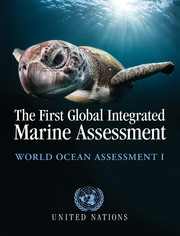Book contents
- Frontmatter
- Dedication
- Epigraph
- Contents
- Foreword and Preface
- Preface
- Summary of the first global integrated marine assessment
- The context of the assessment
- Assessment of Major Ecosystem Services from the Marine Environment (Other than Provisioning Services)
- Chapter 3 Scientific Understanding of Ecosystem Services
- Chapter 4 The Ocean's Role in the Hydrological Cycle
- Chapter 5 Sea-Air Interactions
- Chapter 6 Primary Production, Cycling of Nutrients, Surface Layer and Plankton
- Chapter 7 Calcium Carbonate Production and Contribution to Coastal Sediments
- Chapter 8 Aesthetic, Cultural, Religious and Spiritual Ecosystem Services Derived from the Marine Environment
- Chapter 9 Conclusions on Major Ecosystem Services Other than Provisioning Services
- Assessment of the Cross-cutting Issues: Food Security and Food Safety
- Assessment of Other Human Activities and the Marine Environment
- Assessment of Marine Biological Diversity and Habitats
- Section A Overview of Marine Biological Diversity
- Chapter 36 Overview of Marine Biological Diversity
- Section B Marine Ecosystems, Species and Habitats Scientifically Identified as Threatened, Declining or Otherwise in need of Special Attention or Protection
- I Marine Species
- II Marine Ecosystems and Habitats
- Section C Environmental, economic and/or social aspects of the conservation of marine species and habitats and capacity-building needs
- Overall Assessment
- Annexes
- References
Chapter 3 - Scientific Understanding of Ecosystem Services
from Assessment of Major Ecosystem Services from the Marine Environment (Other than Provisioning Services)
Published online by Cambridge University Press: 18 May 2017
- Frontmatter
- Dedication
- Epigraph
- Contents
- Foreword and Preface
- Preface
- Summary of the first global integrated marine assessment
- The context of the assessment
- Assessment of Major Ecosystem Services from the Marine Environment (Other than Provisioning Services)
- Chapter 3 Scientific Understanding of Ecosystem Services
- Chapter 4 The Ocean's Role in the Hydrological Cycle
- Chapter 5 Sea-Air Interactions
- Chapter 6 Primary Production, Cycling of Nutrients, Surface Layer and Plankton
- Chapter 7 Calcium Carbonate Production and Contribution to Coastal Sediments
- Chapter 8 Aesthetic, Cultural, Religious and Spiritual Ecosystem Services Derived from the Marine Environment
- Chapter 9 Conclusions on Major Ecosystem Services Other than Provisioning Services
- Assessment of the Cross-cutting Issues: Food Security and Food Safety
- Assessment of Other Human Activities and the Marine Environment
- Assessment of Marine Biological Diversity and Habitats
- Section A Overview of Marine Biological Diversity
- Chapter 36 Overview of Marine Biological Diversity
- Section B Marine Ecosystems, Species and Habitats Scientifically Identified as Threatened, Declining or Otherwise in need of Special Attention or Protection
- I Marine Species
- II Marine Ecosystems and Habitats
- Section C Environmental, economic and/or social aspects of the conservation of marine species and habitats and capacity-building needs
- Overall Assessment
- Annexes
- References
Summary
Introduction to the concept of ecosystem services from oceans
Humanity has always drawn sustenance from the ocean through fishing, harvesting and trade. Today 44 per cent of the world's population lives on or within 150 kilometres from the coast (United Nations Atlas of Oceans). However this fundamental connection between nature and people has only very recently been incorporated into trans-disciplinary thinking on how we manage and account for the human benefits we get from nature. Today, when a product taken from an ecosystem1, for example, fibres, timber or fish, enters the economic cycle (i.e., a part of the human system), it receives a monetary value that accounts at least for the costs associated with its extraction and mobilization. If that natural product is the result of cultivation, as in the case of agriculture, forestry and aquaculture, the monetary value also includes the production costs. However, the extraction of natural products and other human benefits from ecosystems has implicit costs of production and other ancillary costs associated with preserving the integrity of the natural production system itself. Traditionally these benefits and costs have been hidden within the “natural system,” and are not accounted for financially; such hidden costs and benefits are considered “externalities” by neoclassical economists. While the neoclassical economic toolbox includes non-market valuation approaches, an ecosystem services approach emphasizes that ‘price’ is not equal to “value” and highlights human well-being, as a normative goal. The emergence and evolution of the ecosystem services concept offers an explicit attempt to better capture and reflect these hidden or unaccounted benefits and associated costs when the natural “production” system is negatively affected by human activities. The ecosystem services approach has proven to be very useful in the management of multi-sector processes and already informs many management and regulatory processes around the world (e.g. United Kingdom National Ecosystem Assessment, 2011).
Ecosystems, including marine ecosystems, provide services to people, which are life-sustaining and contribute to human health and wellbeing (Millennium Ecosystem Assessment, 2005; de Groot, 2011). The Millennium Ecosystem Assessment defines an ecosystem as “a dynamic complex of plant, animal and micro-organism communities and their non-living environment interacting as a functional unit” and goes on to define ecosystem services as “the benefits that humans obtain from ecosystems” (p. 27).
- Type
- Chapter
- Information
- The First Global Integrated Marine AssessmentWorld Ocean Assessment I, pp. 67 - 90Publisher: Cambridge University PressPrint publication year: 2017

